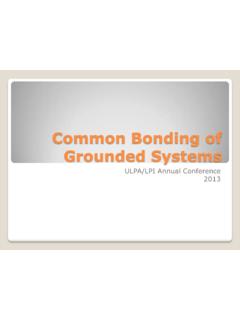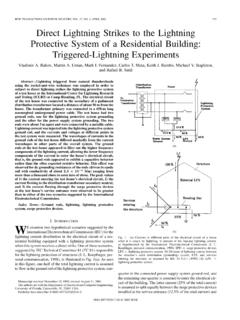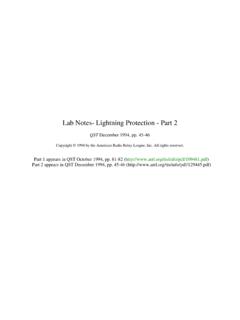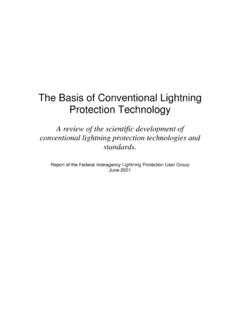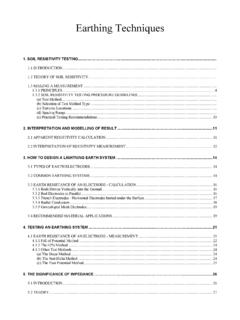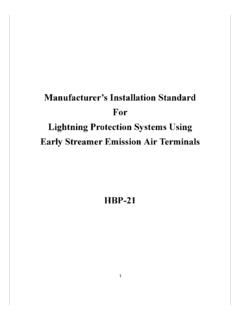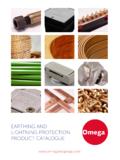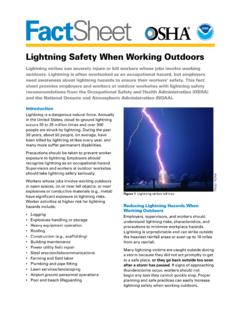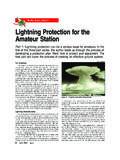Transcription of Common Bonding of Grounded Systems - Lightning
1 Common Bonding of Grounded Systems ULPA/LPI Annual Conference 2013. NEC - Grounding Electrodes. (A) Electrodes Permitted for Grounding. 1. Metal Underground Water Pipe. A metal underground water pipe in direct contact with the earth for m (10 ft.) or more .. 2. Metal Frame of the Building or Structure. The metal frame of the building or structure that is connected to the earth .. 3. Concrete-Encased Electrode. A concrete-encased electrode shall consist of at least m (20 ft.) of either . 4. Ground Ring. A ground ring encircling the building or structure, in direct contact with the earth, consisting of 5. Rod and Pipe Electrodes. Rod and pipe electrodes shall not be less than m (8 ft.) in length and shall consist of the following materials . 6. Other Listed Electrodes. 7. Plate Electrodes. Each plate electrode shall expose not less than m2 (2 ft2) of surface to exterior soil.
2 8. Other Local Metal Underground Systems or Structures. NEC - Grounding Electrodes . (contd.). (B) Not Permitted for Use as Grounding Electrodes. The following Systems and materials shall not be used as grounding electrodes: (1) Metal underground gas piping Systems (2) Aluminum NEC - Grounding Electrode system . All grounding electrodes as described in (A)(1) through (A)(7) that are present at each building or structure served shall be bonded together to form the grounding electrode system . Where none of these grounding electrodes exist, one or more of the grounding electrodes specified in (A)(4) through (A)(8) shall be installed and used. Grounding Electrode Conductor and Bonding Jumper Connection to Grounding Electrodes. The connection of a grounding electrode conductor at the service, at each building or structure where supplied by a feeder(s) or branch circuit(s), or at a separately derived system and associated Bonding jumper(s) shall be made.
3 (A) Accessibility. All mechanical elements used to terminate a grounding electrode conductor or Bonding jumper to a grounding electrode shall be accessible. (B) Effective Grounding Path. The connection of a grounding electrode conductor or Bonding jumper to a grounding electrode shall be made in a manner that will ensure an effective grounding path. (C) Metallic Water Pipe and Structural Metal. Grounding electrode conductors and Bonding jumpers shall be permitted to be connected at the following locations and used to extend the connection to an electrode(s): (1) Interior metal water piping located not more than m (5 ft.) from the point of entrance to the building shall be permitted to be used as a conductor to interconnect electrodes that are part of the grounding electrode system . (2) The structural frame of a building that is directly connected to a grounding electrode NEC - Bonding of Piping Systems and Exposed Structural Steel.
4 (A) Metal Water Piping Metal water piping system (s) installed in or attached to a building or structure shall be bonded to the service equipment enclosure, the Grounded conductor at the service, the grounding electrode conductor where of sufficient size, or to the one or more grounding electrodes used. (B) Other Metal Piping. If installed in, or attached to, a building or structure, a metal piping system (s), including gas piping, that is likely to become energized shall be bonded . (C) Structural Metal. Exposed structural metal that is interconnected to form a metal building frame and is not intentionally Grounded or bonded and is likely to become energized shall be bonded . (D) Separately Derived Systems . Metal water piping Systems and structural metal that is interconnected to form a building frame shall be bonded to separately derived Systems .
5 ANSI/TIA-607-B Generic Telecommunications Bonding and Grounding (Earthing) for Customer Premises This Standard provides basic principles, components, and design of telecommunications Bonding and grounding that shall be followed to ensure that the telecommunication Bonding and grounding Systems within a building will have one electrical potential. For a designer of telecommunications Bonding and grounding Systems , the ANSI/TIA-607-B standard is the most encompassing standard to follow for premises buildings. For electrical contractors subcontracting out the telecommunications work, the demarcation point for work between electrical and telecommunications contractors should be carefully coordinated. A recommended practice is for the electrical contractor to provide the grounding conductor and connection from the main electrical ground to the TMGB, as well as from an electrical panel in a telecommunications room to the grounding busbar in that room.
6 The telecommunications contractor would then provide all of the grounding busbars and Bonding conductors within and between the telecommunications rooms, as well as make all final connections to the TMGB, TGBs, and telecommunications infrastructure / equipment. (TMGB = Telecommunication Main Ground Bar). ----------- ----- 2014. Edition NFPA 780 - 2014. Common Bonding of Grounded Systems . General. All Grounded media and buried metallic conductors that can assist in providing a path for Lightning currents in or on a structure shall be interconnected to the Lightning protection system within vertical meters (12. vertical feet) of the base of the structure to provide a Common ground potential. For structures exceeding 18 m (60 ft.) in height, the interconnection of the Lightning protection system grounding electrodes and other Grounded media shall be in the form of a ground loop conductor.
7 This interconnection shall include all building grounding electrode Systems including Lightning protection, electric service, communication, and antenna system grounding electrodes. Interconnection of underground metallic piping Systems shall include water service, well casings located within m (25 ft.) of the structure, gas piping, underground conduits, underground liquefied petroleum gas piping Systems , and so on. If the water pipe is not electrically continuous due to the use of plastic pipe sections or other reasons, the nonconductive sections shall be bridged with main size conductors, or the connection shall be made at a point where electrical continuity is ensured. When the building Grounded Systems noted above are interconnected at a Common accessible point in or on the structure, the Lightning protection system shall have only one main size conductor connected to the Common Bonding point.
8 This Common Bonding point shall include a ground bar, a section of water pipe, or the metallic structural frame per NFPA. 70. Where Bonding of the Lightning protection grounding system , Grounded media, and buried metallic conductors has not been accomplished at a Common point, interconnection shall be provided according to the following: A. Grounded media and buried metallic conductors shall be bonded to the Lightning protection grounding system below a height 12. ft. ( m) vertically above the base of the structure. B. Grounded media and buried metallic conductors inherently bonded through construction to the Lightning protection grounding system shall not require further Bonding . C. The continuous metal framework of a structure shall be connected to the Lightning protection system (See and ). D. Main size Lightning conductors shall be used for direct connection of Grounded media and buried metallic conductors to the Lightning protection system .
9 E. A ground bar designed for interconnection of building Grounded Systems shall have one connection to the Lightning protection system . F. A continuous metal water pipe system designed for interconnection of building Grounded Systems shall be connected to the Lightning protection system . G. Interconnection to a gas line shall be made on the customer's side of the meter. H. Where galvanic corrosion is a concern or where a direct bond is prohibited by local code, an isolating spark gap shall be permitted. w here: d = horizontal distance from system component to Grounded body in question h = vertical height betw een bond under consideration and actual bond to the system value related to dow n conductors 25 ft. ( m) apart w ithin 100 ft. (30 m) zone of bond n = under consideration n = 1 w here only 1 dow nconductor in the zone n = w here only 2 dow nconductors in the zone n = w here 3 or more dow nconductors in the zone n = total number of system dow nleads below 60 ft.
10 (18 m) from top ground loop (roof circuit). Km = medium betw een system and Grounded body in question Km = 1 if flashover w ill occur through air Km = if flashover w ill occur through non-metallic building materials Variable Value h= 60 (insert height to nearest bond w ith system ). n= (insert value for n from above - 1, , , or total of dow nleads). Km = 1 (insert value for Km from above - 1 or ). (calculated distance w ithin w hich a bond betw een Systems is required or potential d= sideflash distance). UL STP Proposals 10. New UL 96A Proposal - Addition of Paragraph RATIONALE. Paragraph proposed to be added to accommodate compliance to changes in NFPA 70. PROPOSAL. If utility services are Grounded to a Common bus bar, then Common (equipotential) Bonding shall be accomplished by attaching a main size conductor to that bus bar with an appropriately sized Bonding fitting.


